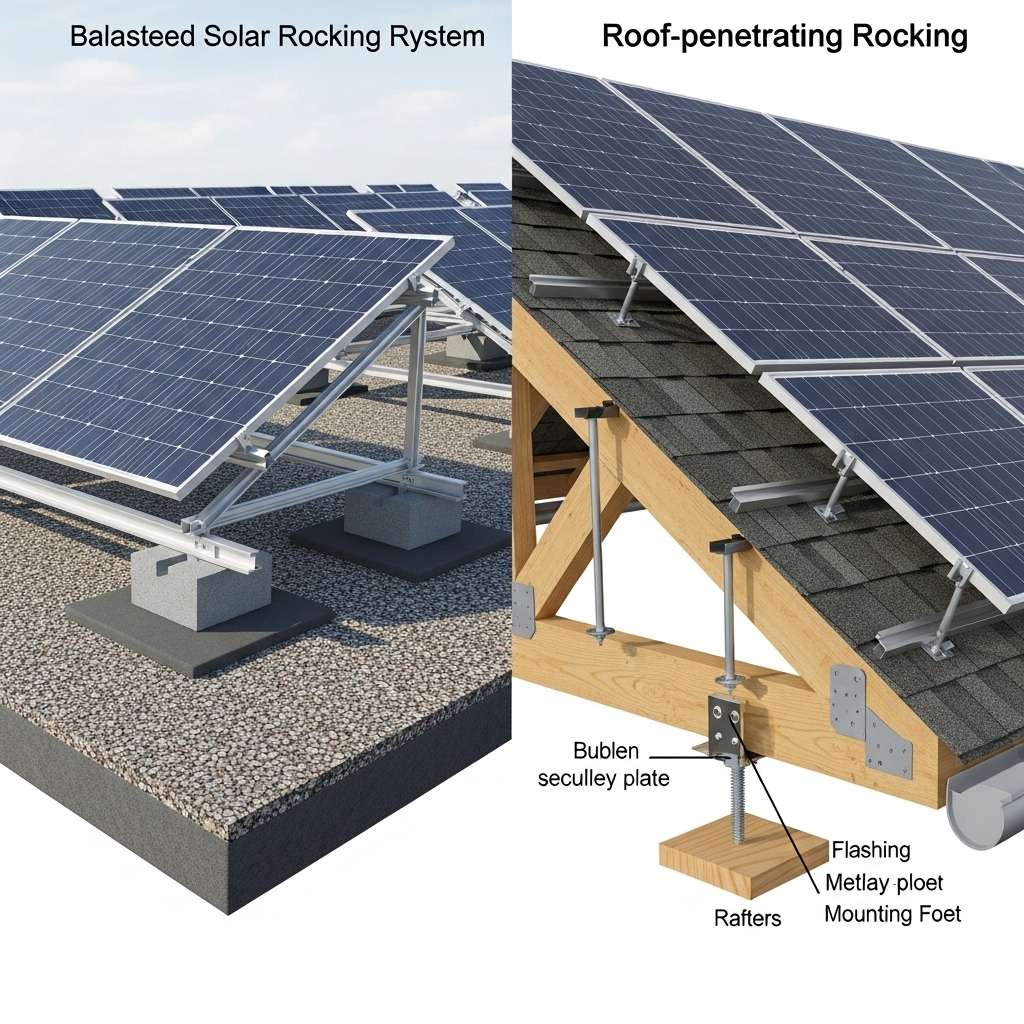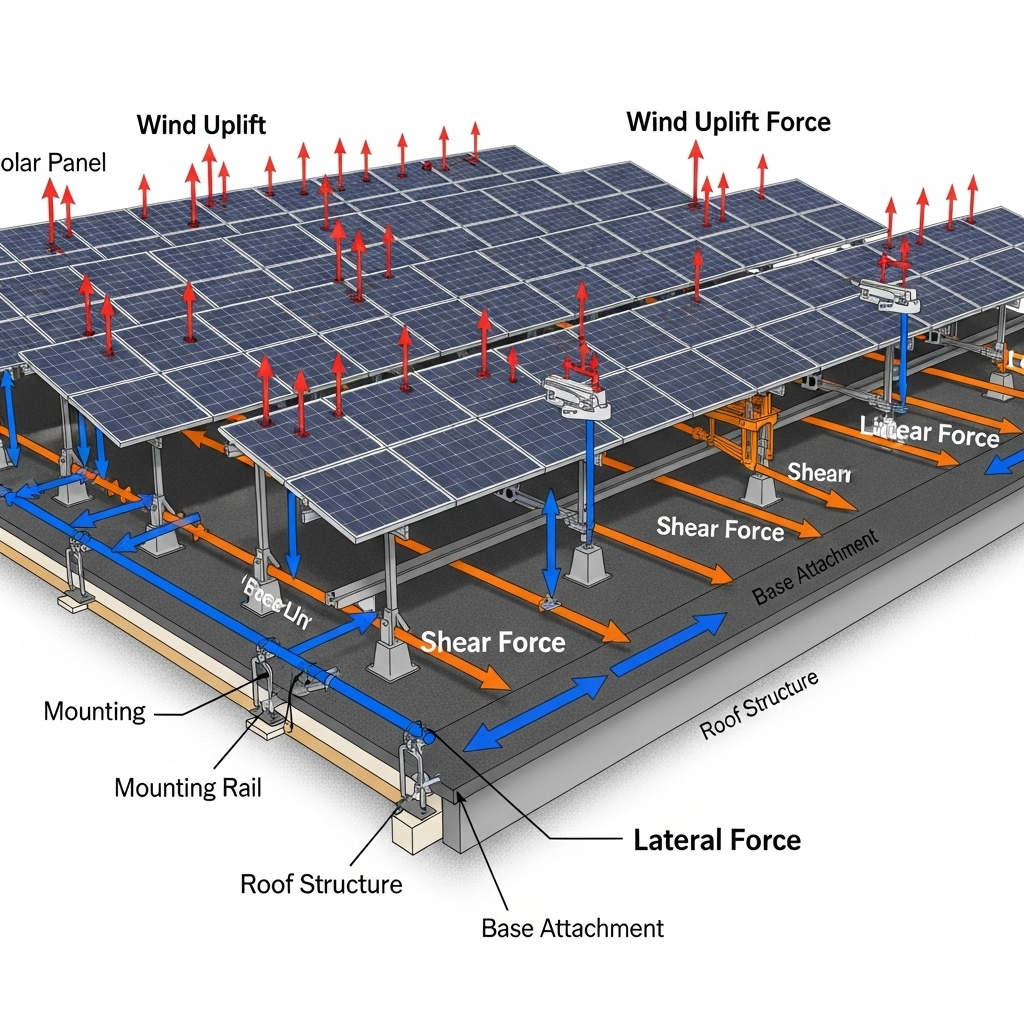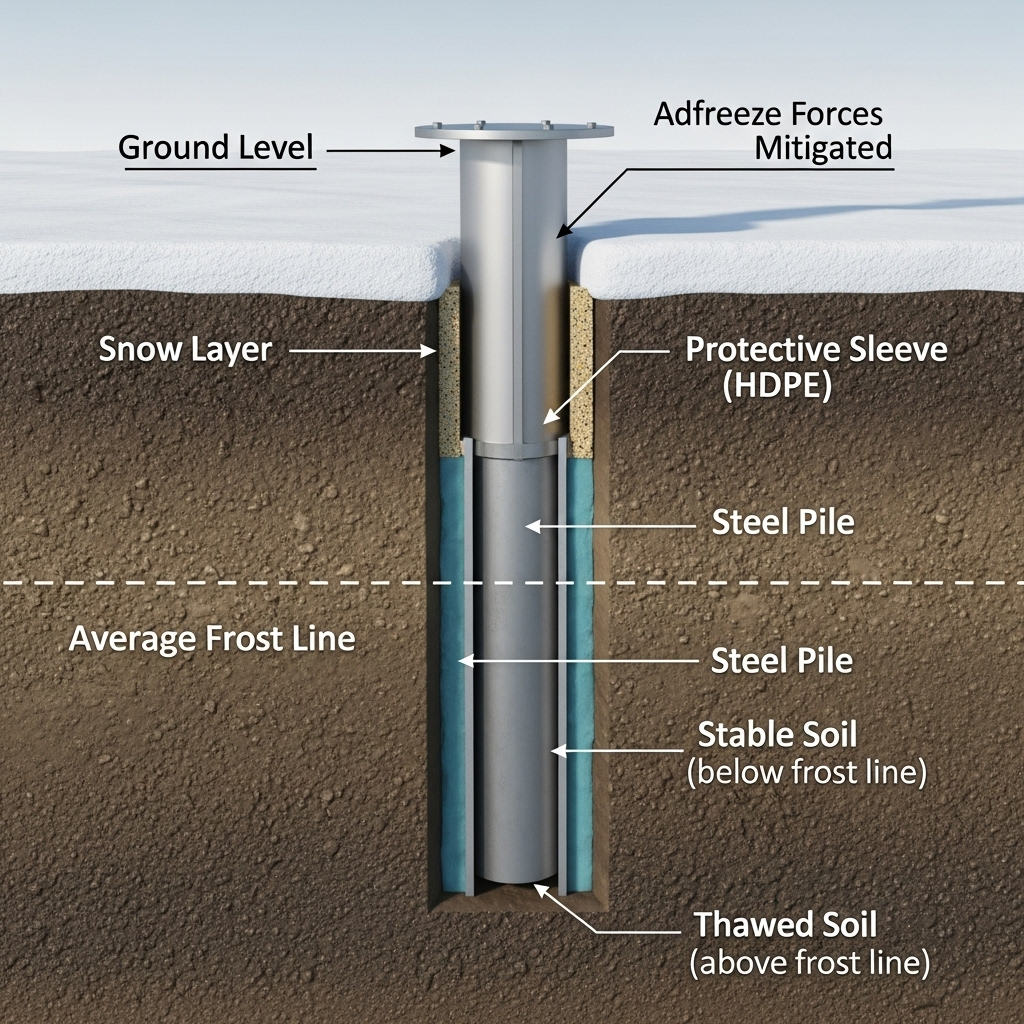Choosing the right mounting system is a foundational step in any rooftop solar installation. The structure that holds your panels determines not only the system's longevity and performance but also the integrity of your roof. The two primary options for this critical job are ballasted racks and roof-penetrating racks. Each approach has specific applications, and the best choice depends on your roof's design, structural capacity, and local climate conditions.
Understanding Roof-Penetrating Racking Systems
Roof-penetrating racks are the most common choice for residential solar installations, especially on sloped roofs. This method provides a direct and secure connection to the building's structure.
How They Work: The Mechanics of Attachment
This type of solar roof mounting involves securing the racking directly to the roof's structural beams, known as rafters. Installers drill pilot holes through the roofing material and into the rafters below. Lag bolts are then driven into the rafters, and a flashing plate with a waterproof sealant is installed around each penetration point. This creates a durable, watertight seal that prevents leaks. The rails that hold the solar panels are then attached to these mounting points, ensuring the entire array is firmly anchored. While the process involves creating holes, professional installation minimizes any risk of water intrusion.
Key Advantages and Potential Risks
The primary advantage of a penetrating system is its exceptional strength and stability. By anchoring directly to the building's frame, it offers superior resistance to wind uplift, making it ideal for regions prone to high winds or hurricanes. This method is also versatile, working on nearly any type of sloped roof, including asphalt shingle, tile, and metal. The main risk is the potential for roof leaks if the installation is not performed correctly. Improperly sealed penetrations can allow water to seep in over time, which is why selecting a qualified and experienced installer is crucial. Additionally, this method can sometimes affect the roof's warranty, so it is important to check with your roofing manufacturer.
Ideal Use Cases
Roof-penetrating racks are the standard for most residential homes with sloped roofs. They are particularly well-suited for areas that experience significant weather events, such as heavy snow or high winds. Their robust design ensures the solar array remains secure under substantial stress, protecting both the system and the home itself.
Exploring Ballasted Racking Systems
For flat or low-slope roofs, particularly on commercial buildings, ballasted racking systems offer a compelling alternative that avoids roof penetrations altogether.
The No-Penetration Approach
Instead of bolts and screws, ballasted racks use weight to hold the solar array in place. Concrete blocks or other heavy materials are placed in trays integrated into the racking structure, using gravity to secure the system against wind and other forces. The entire system rests on the roof's surface, often with a protective slip sheet between the rack and the roof membrane to prevent abrasion. Many designs also incorporate wind deflectors to reduce the aerodynamic lift on the panels, decreasing the amount of weight needed for stability.
Benefits and Inherent Limitations
The most significant benefit of a ballasted system is that it preserves the integrity of the roof membrane. With no penetrations, the risk of leaks is virtually eliminated, and the building's roof warranty remains intact. Installation can also be faster and less labor-intensive, which may lower upfront costs. However, these systems have limitations. They add a substantial amount of weight to the roof, requiring a structural assessment to ensure the building can support the load. They are only suitable for flat or very low-slope roofs, typically with a pitch of less than 10 degrees. In high-wind areas, the amount of ballast required can become impractical, sometimes necessitating a hybrid approach with some mechanical attachments.
Common Applications
Ballasted racks are the go-to solution for large, flat commercial roofs, such as those on warehouses, data centers, and big-box stores. They are also ideal for buildings where roof penetrations are prohibited or for property owners who want a system that can be easily removed if the building is sold or the lease ends.

Cost Analysis: Penetrating vs. Ballasted Mounts
The financial calculation for choosing a solar racking system involves more than just the price of hardware. Labor, long-term maintenance, and potential roof repairs all factor into the total cost of ownership.
Upfront Equipment and Labor Costs
On a per-watt basis, the material costs for penetrating racks are often slightly lower than for ballasted systems, which require heavy and bulky concrete blocks. However, labor costs can be higher for penetrating systems due to the precision required to locate rafters and properly seal each attachment point. For large, open flat roofs, ballasted systems can be deployed very quickly, potentially leading to lower overall installation costs.
Long-Term Maintenance and Roof Repair Considerations
Long-term costs diverge based on the system type. With penetrating racks, there is a small but persistent risk of leaks, which could lead to expensive repairs if the initial installation was subpar. For ballasted systems, the primary concern is ensuring the ballast blocks do not shift over time and that the roof membrane is not being unduly compressed. According to some roofing professionals, ballasted systems can make routine roof inspections and maintenance more difficult, potentially allowing minor issues to become major problems.
Comparative Cost Table
| Feature | Roof-Penetrating Racks | Ballasted Racks |
|---|---|---|
| Material Cost | Generally lower per watt | Can be higher due to ballast weight |
| Labor Cost | Higher due to precision work | Potentially lower for large projects |
| Roof Slope | Suitable for most slopes | Flat or low-slope roofs only (<10°) |
| Wind Resistance | Excellent, directly anchored | Good, relies on weight and engineering |
| Roof Integrity | Involves penetrations | No penetrations, preserves warranty |
| Structural Load | Distributes load on rafters | Concentrates significant weight |
| Best For | Sloped residential roofs, high-wind areas | Flat commercial roofs, protected areas |
Making the Right Choice for Your Solar Project
Selecting the appropriate solar roof mounting system is a decision that requires careful evaluation of your specific circumstances. A thorough assessment of your property and goals is essential.
Assessing Your Roof's Characteristics
The first step is a professional evaluation of your roof. Key factors include its material (asphalt, tile, metal, membrane), age, slope, and underlying structural capacity. For a ballasted system, a structural engineer's report is almost always required to confirm that the roof can safely support the additional weight. An older roof may not be a good candidate for any type of solar installation without repairs or replacement first.
Aligning with Local Building Codes and Climate
Local building codes, particularly those related to wind and snow loads, will heavily influence your choice. Areas with high wind speeds or heavy snowfall will have stringent requirements that may favor a penetrating system's direct anchoring. Your solar installer should be well-versed in these local regulations to ensure a compliant and safe installation.
Integrating with Your Energy System
A stable, well-installed rack ensures your panels operate efficiently for decades, forming the physical foundation of your entire energy system. Optimizing the physical installation is just one part of the equation. Understanding how your panels, inverter, and storage work together is crucial for maximizing your energy independence. For a deeper look into system efficiency, the ultimate reference on solar storage performance provides valuable insights into component synergy.
Final Considerations for Your Racking System
The choice between ballasted and roof-penetrating racks boils down to a trade-off between preserving roof integrity and achieving maximum structural strength. There is no single 'best' option; the ideal solution is highly dependent on the specifics of your project. Consulting with qualified solar installers and structural engineers is the most reliable way to navigate this decision. They can provide a comprehensive assessment and recommend a system that ensures safety, longevity, and optimal performance for your solar investment.
Disclaimer: This information is for educational purposes only and does not constitute financial or legal advice. Consult with qualified professionals before making any investment decisions.
Frequently Asked Questions
Can a ballasted system be used on a sloped roof?
Generally, no. Ballasted systems rely on gravity and friction to remain in place, making them unsafe for roofs with a significant pitch. They are designed exclusively for flat or low-slope surfaces, typically with an angle of 10 degrees or less.
Do roof-penetrating mounts always cause leaks?
Not if installed correctly. Professional installers use specialized flashing, gaskets, and industrial-grade sealants designed to create a durable, watertight barrier around each penetration point. When performed to industry standards, the risk of leaks is minimal.
Which system is better in a hurricane-prone area?
A properly engineered and installed roof-penetrating system is typically preferred in high-wind zones. Its direct connection to the building's structure provides superior resistance to the powerful uplift forces generated by hurricane-level winds.
Does the weight of a ballasted system damage the roof?
It can if the roof is not designed to support the additional load. A structural assessment by a qualified engineer is mandatory before installing a ballasted system. This evaluation ensures the roof can handle the concentrated weight of the concrete blocks and panels without compromising its structural integrity.





Leave a comment
All comments are moderated before being published.
This site is protected by hCaptcha and the hCaptcha Privacy Policy and Terms of Service apply.